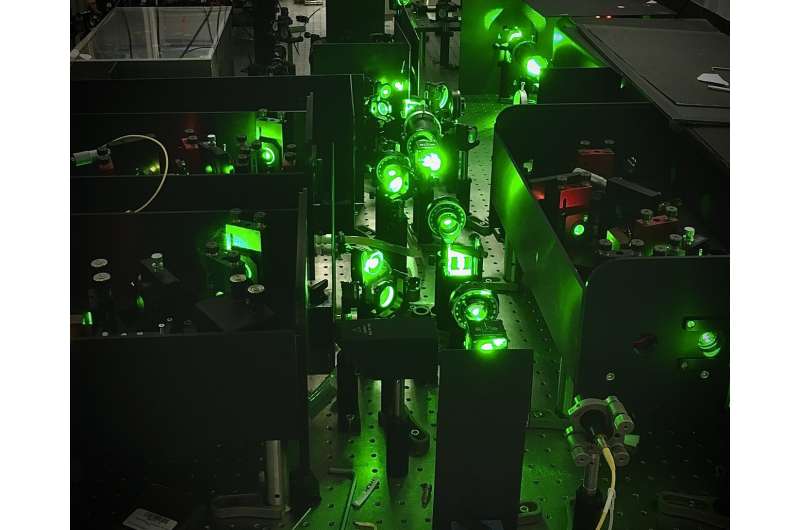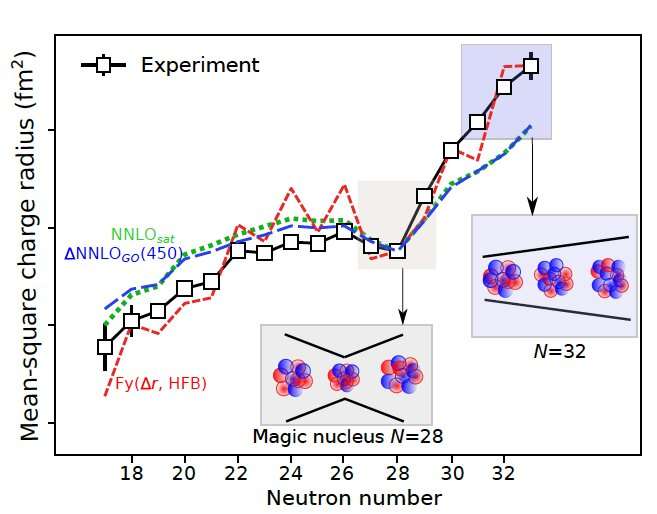March 3, 2021 feature
Researchers unveil issues with nuclear theory, observe no magic behavior at N=32 in charge radii of potassium isotopes

Measuring the size of atomic nuclei has sometimes been useful to probe aspects of nucleon-nucleon interaction and the bulk properties of nuclear matter. The charge radius of atomic nuclei, which can be extracted using laser spectroscopy techniques, is sensitive to both the bulk properties of nuclear matter and particularly subtle details of the interactions between protons and neutrons.
Many recent studies have thus examined the properties of nuclei with unbalanced proton-to-neutron ratios, known as exotic nuclei. These exotic nuclei have been found to exhibit new phenomena and thus have proved valuable for testing nuclear theory and improving the current understanding of nuclear forces.
Among other things, examining exotic nuclei can help to identify new magic numbers. In this context, the term 'magic numbers' refers to the number of protons or neutrons that correspond to completely filled shells in these nuclei.
A research team led by physicists at Instituut voor Kern-en Stralingsfysica, KU Leuven, in Belgium and by Peking University in China have recently carried out a study examining exotic potassium isotopes with 32 neutrons, which was predicted to be a magic number. Their paper, published in Nature Physics, presents evidence that challenges state-of-the-art nuclear theories.
"The magic character of a proton or neutron number, among others, is reflected in a smaller size of the magic nucleus, compared to its neighbors," Agota Koszorus, one of the researchers who carried out the study, told Phys.org. "There are several well know magic numbers such as 2, 8 20 or 28, however in the mass region of the potassium isotopes, 32 has been proposed as a new magic neutron number. The goal of our experiment was to measure the charge radius of the potassium isotope which has 33 neutrons and allow for the comparison of the size of the proposed magic N=32 isotope to its lighter (N=31) and heavier (N=33) neighbors."
Identifying new magic numbers has been the key objective of many recent studies investigating nuclear structures. Studying neutron-rich isotopes such as the ones examined by Koszorus and her colleagues, however, can be very challenging, for several reasons.
Firstly, these isotopes can only be produced at radioactive ion beam facilities like ISOLDE at CERN. In addition, they generally have very short half-lives (e.g., 110 ms long in the case of 52K). This means that once they are produced researchers have a very limited time to prepare them for measurements and to actually examine them. In the specific case of 52K, an additional challenge was the large isobaric contamination in the beam produced at ISOLDE.
"N=32 is one proposed new neutron magic number in the Ca region based on the nuclear mass measurement and 2+ energies measurement," Xiaofei Yang, another researcher involved in the study, told Phys.org. "However, this magic effect has not yet been confirmed from the nuclear moments or radii measurements due to the limited experimental information in the Ca region."
Koszorus, Yang and their colleagues were the first to study charge radii above N=32 and this ultimately allowed them to determine whether the "magic effect" appeared in the nuclear radii. A further objective of their study was to investigate the recent progress made in the development of models based on nuclear theory.

"Even though at the ISOLDE facility the ions are mass selected before they are delivered to the experimental setups, there is a stable chromium isotope with very similar mass, which is abundant in nature, and in the environment of the production site of ISOLDE," Koszorus explained. "This meant that while every second 200 52K isotopes were delivered to our experimental setup, 6 million stable Cr isotopes were also delivered, which resulted in overwhelming background rates. We therefore had to modify our setup to rely on detection of the beta particles emitted in the radioactive decay of 52K. The stable Cr could therefore not contribute to the background."
Interestingly Koszorus, Yang and their colleagues found no sign of magic behavior in the evolution of the potassium isotope's nuclear size across the N=32 neutron number. The researchers also compared their observations to the results of calculations based on state-of-the-art theoretical nuclear models, namely the energy density functional (DFT) method and the coupled cluster (CC) theory.
"The DFT is an ideal method for heavier nuclei, whereas the CC model is more suitable for light and medium mass nuclei," Koszorus said. "The potassium region is a compelling meeting ground to test these approaches simultaneously. Both theoretical methods need information about the nuclear interactions. For this purpose, state-of-the art nuclear structure models were applied: The DFT calculations employed highly successful Fayans energy density functional and CC calculations used ab-initio chiral potential."
The researchers found that the theoretical models successfully predicted the changes in the mean-square charge radii that they observed in isotopes below the N=28 magic number. The models they tested appeared useful for modeling isotopes with unpaired protons and neutrons.
"From the comparison between the measured and predicted changes in the mean-square charge radii it is clear that the calculations perform very well in predicting the general trend below the N=28 magic number, successfully taking on the challenge of modeling isotopes with unpaired protons and neutrons," Koszorus said. "At a closer look, however, it becomes apparent that the ab initio coupled cluster calculations fall short in predicting the steep increase in the charge radii of the neutron rich isotopes."
The researchers hypothesized that the issues and inconsistencies between the coupled cluster calculations and their measurements could be rooted in the many-body nature of the CC model. On the other hand, while the Fayans DFT model predicted the general trend they observed very well, it overestimated the variation between the size of odd and even mass isotopes.
Overall, these findings suggest that existing nuclear theories might need to be perfected further before they can effectively predict magic numbers in exotic isotopes. In other words, it would seem that the current understanding of the nuclear properties and structure of neutron-rich isotopes is still very limited. In the future, the methods used by this team of researchers could be used to study other exotic isotopes with short lifespans.
"The story of the newly emerging magic numbers around the potassium isotopes is far from over, and another magic number was proposed at neutron number 34," Koszorus said. "The study of these nuclei requires even higher experimental efficiently since the production yields are below 100 ions per second. We are continuously working on technical developments to improve our experimental setup and soon we will be ready to push the limits or the current state-of-the-art techniques and test our understanding of the nuclear structure of very neutron-rich isotopes nuclei."
A key goal of many contemporary nuclear physics studies is to explore the limits and properties of atomic nuclei governed by nuclear forces, in order to better understand their structure. In their next studies, Koszorus, Yang and their colleagues also plan to develop increasingly advanced laser spectroscopy techniques, as these could be used to examine atomic nuclei with greater precision and collect more reliable measurements.
More information: Charge radii of exotic potassium isotopes challenge nuclear theory and the magic character of N = 32. Nature Physics(2021). DOI: 10.1038/s41567-020-01136-5.
Journal information: Nature Physics
© 2021 Science X Network




















